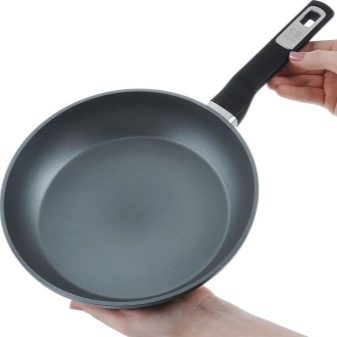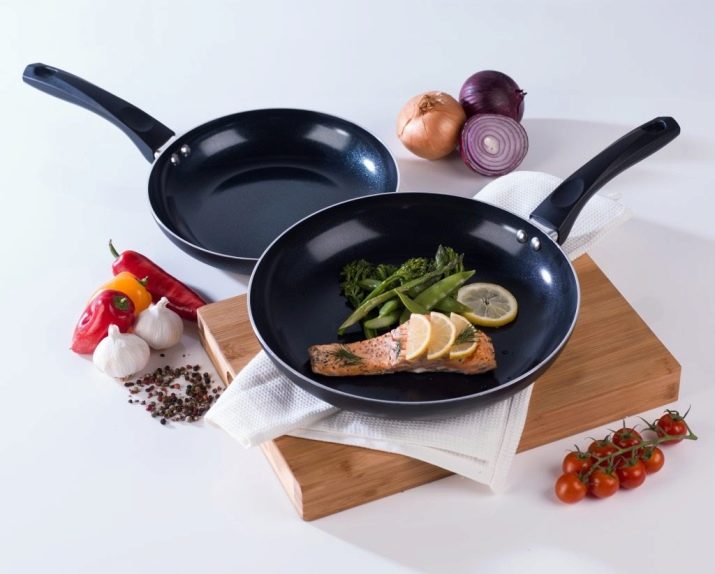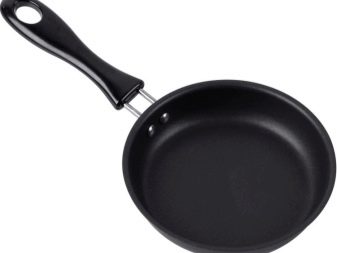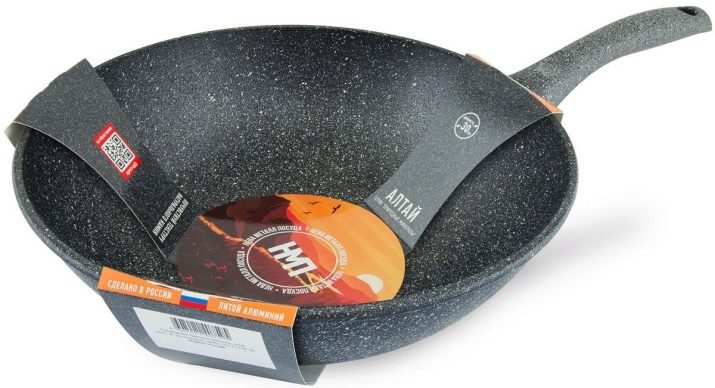Non-stick pans: pros and cons, types and selection criteria

A frying pan is an essential attribute in every kitchen. This is a container that is directly involved in the cooking process. If earlier almost everyone used cast iron pans, today the assortment is more than large. The modern cookware market offers many options for the consumer to choose from, but non-stick coated products are the most popular. We will talk about them in this article.


What it is?
A non-stick coating is a protective layer, the main purpose of which is to protect the surface of the container used from burning and scale formation. The frying pan is used for frying food, and the material from which it is made tends to oxidize, thereby forming scale and waste at the bottom of the container. The non-stick coating avoids this and does not spoil the food that is being cooked.
The non-stick frying pan looks the same as the familiar frying pan. That is, visually it is no different, only its bottom is covered with a protective layer. There are models that have a similar protective layer on the outside. Due to the properties of the coating, pans with such a protective layer are popular with housewives.


Views
The non-stick frying pan can be made from a variety of materials. Let's take a look at the best types of coatings.
- Teflon. This is the most popular type of non-stick coating. It was Teflon that was the first non-stick material to be applied to pans.For its production, polytetrafluoroethylene is used - a chemical compound obtained in 1938.

- Ceramic. It is a nanocomposite polymer substance composed of the smallest particles of sand. In practice, two methods of applying this protective layer are used: spraying and rolling. In the first case, the outer and inner sides of an already made pan are covered. This method makes it possible to obtain a reliable, durable and practical container with a perfectly flat bottom. Rolling involves applying a protective layer to a metal sheet, from which the pan will be made in the future. Containers made by this method are called cast. It is also worth noting that there are many different options for a frying pan with a ceramic protective layer. For example, this is a white coating, which is obtained by staining ceramics.

- Marble. The marble coating of the frying pan is the same Teflon, only with the addition of marble chips to the protective layer.

- Made of non-composite materials. This frying pan is granite, titanium and diamond coated. Frying pans with these types of coating are the most expensive. The cost of the container is due to the properties of the substances used.



Advantages and disadvantages
Earlier in the article, we talked about what types of non-stick protective layer exist. Now it's time to discuss in more detail the advantages and disadvantages of each of the above types.
Teflon
This type of non-stick coating is considered the ancestor of all protective layers.
The benefits are quite weighty:
- has high non-stick properties;
- unpretentious care;
- affordable price.
But there are also a lot of disadvantages:
- the maximum heating temperature is 200 ° C, this is due to the fact that Teflon, when exposed to high temperatures, begins to emit harmful substances;
- when frying food, it is advisable to use vegetable or butter;
- the container cannot be used for long-term cooking;
- the teflon coating is unstable: any mechanical impact on it will lead to deformation and damage;
- if the Teflon protective layer in the pan is damaged, then using the container further is strongly discouraged, it is harmful to health;
- you cannot cool a hot container with cold water.


Ceramic
Such a frying pan is in great demand today, and there are several reasons for this:
- resistance to high temperatures - the pan can be heated up to 450 ºС;
- easy to care for;
- when cooking, you need a minimum of oil.
Cons of ceramics:
- does not tolerate temperature changes;
- when stirring, do not use metal spatulas and devices;
- you need to use special detergents and an exceptionally soft sponge.

Marble
This type of protective coating has a number of advantages:
- resistance to mechanical stress;
- fast and uniform heating;
- the ability to maintain temperature for a long time;
- does not deform when exposed to high temperature or its drops;
- the cooking process takes place without adding oil;
- long service life, which with proper care can be about 2 years.
No matter how many advantages this type of coating has, there are some disadvantages:
- a marbled frying pan is quite expensive;
- the coating deteriorates when used during washing with abrasive and chemical substances;
- there are restrictions on the use of a dishwasher;
- under strong mechanical stress, the coating may collapse.

From non-composite materials
To the benefits of a coated pan non-composite substances include:
- reliability and quality;
- long service life;
- fast and uniform heating;
- a surface that is resistant to mechanical stress: it can be scratched with a knife, forks, nothing will damage it;
- temperature preservation.
Among the disadvantages are the high cost and the impossibility of using a frying pan on an induction hob.

Sizes and shapes
Sizes and shapes, as a rule, depend on the purpose of the container and on the products that will be fried on it.
The shape of the pan can be:
- round;
- square;
- rectangular;
- oval.




Let's take a look at some of the more well-known types of non-stick pans.
- Classic. Such a frying pan can be any. It is used for frying, stewing and sautéing. The diameter of a classic frying pan is 20-28 centimeters.

- Stewpan. This is the name given to a container with thick sides. Its bottom is always grooved. The saucepan comes on sale with a thermometer and a thick lid. Its biggest advantage is the uniform and quick heating of the food, which makes it possible to cook anything in a container, from scrambled eggs to boiling soup. The diameter of the saucepan can be 24, 26 and 28 cm.

- Pancake. It is characterized by low sides, flat bottom and non-removable handle. Pancakes and pancakes are baked on the container. The maximum size is 25 cm.

- Brazier. For the manufacture of the brazier, high-strength steel is used. The bottom is made of a special alloy. This container can be used for cooking in the oven. The size is from 20 to 28 cm.

- Grill. A fairly heavy container for frying with a ribbed bottom. Comes on sale complete with a lid. Experts and professional culinary experts say that products cooked in a grill pan do not lose their taste and properties during the frying process, they retain all the vitamins. Sizes are different: 25, 30, 28x28 cm.

- Wok. This is a very large and weighty frying pan, which is characterized by high and strong walls, a wide bottom. It is used for the preparation of sauces, marinades, semi-finished products. The diameter of the wok is between 28 and 32 cm.

Model overview
There are many different manufacturers and models of non-stick pans on the market today. Among all existing brands, I would like to separately highlight and talk about the most popular and well-established brands.
- Tefal (France). This is probably the most famous company that produces pans. Absolutely every model of this brand is produced with a non-stick coating. In production, only high-quality materials and raw materials are used. Tefal's product range is varied. You can find a cast, aluminum, stainless steel pan. As for the cost, there are both budget options and quite expensive ones.

- Rondell. The company was founded in Germany and today has many factories around the world. The cost of this frying pan is very high. This is due to the shelf life, which is set by the manufacturer, and the technical characteristics of the product.

- Kukmara. This frying pan manufacturer is famous for its wide range of products: cast, ceramic and aluminum frying pan with a protective layer.

- TVS. This brand is also very popular, it is presented in various versions. Models with a removable handle are available for sale, which is very convenient, for example, when using an oven.

- Swiss Diamond (Switzerland). This company is known for adding diamond chips to its products during the production process. The cost of production is high, due to the quality and reliability.

- Ballirini (Italy). The products are reliable, safe and have a long service life.

- "Neva metal dishes". Such products are produced at the St. Petersburg plant. The result of the company's work is cast pans with a protective layer. These models are quite popular, this is due to the quality and affordable price.

- Biol. This is a Ukrainian manufacturer that makes pans exclusively from environmentally friendly materials.

It is also worth noting that on the market you can buy not one product, but a whole set.

Selection rules
Choosing a pan is not so easy. In order for the cooking process to meet the requirements and expectations, and the products can be fried well and retain their properties, the choice of a frying pan must be approached very responsibly.
There are certain criteria that should be followed.
- When choosing a frying pan with a Teflon coating, it is better to give preference to a model with a thicker bottom. Make sure that the Teflon protective layer is uniform and free from deformation.
- When choosing a frying pan with a ceramic coating, it is recommended to bypass cheap models. The covering must be at least 4 mm thick.
- When buying a pan with a marble surface, consider the manufacturing method, wall thickness and evenness of the protective layer.
- The manufacturer is also of great importance. Before choosing, it is better to look at reviews of recommended models, read reviews of real people about the manufacturer and its products. This will help you avoid a lot of problems and frustrations.


Operating tips
A non-stick frying pan is expensive. It needs to be properly looked after, this is the only way to extend its service life. Let's take a look at a few recommendations shared by the professionals.
- It is strongly not recommended to use a metal spatula or spoon during the cooking process. Even if the manufacturer indicates that the surface is resistant to mechanical stress, it is still better to take care of it and use a wooden object for stirring.
- The pan should be washed only with a soft washcloth and a special detergent.
- In the process of use, you need to monitor the temperature regime and remember that there are models that do not withstand high temperatures, and, for example, you cannot fry meat on them.
- Avoid sudden temperature changes.
- Allow the dishes to dry naturally after washing.
Be sure to carefully study the instructions, in which the manufacturer must indicate all the rules of operation. There are models of pans that are not designed for induction hobs or those that cannot be installed in the oven. It is strictly forbidden to use utensils with a damaged non-stick coating.

Below, see a video review of popular models of non-stick frying pans.








